Finite Element Models of Gold Nanoparticles and Their Suspensions for Photothermal Effect Calculation
Abstract
1. Introduction
2. Materials and Methods
2.1. Nanoparticle EM Model
- , the cycle averaged total power dissipation density by resistive loss in
- , the time average Poynting vector components of the scattered field in
- , the amplitude of the electric field calculated as in
2.2. Gold NanoStar Model
2.3. NanoStar Suspension in a Well Model
2.4. Experiments on Suspensions of Gold NanoStars
3. Results and Discussion
3.1. Modeled Geometries
3.2. Absorption and Scattering Cross-Section Results
3.2.1. NanoRod Results
3.2.2. NanoStar Results
3.3. Electric Field Enhancement Results
3.4. NanoStar Suspension in a Well Model
4. Conclusions
Supplementary Materials
Author Contributions
Funding
Institutional Review Board Statement
Informed Consent Statement
Data Availability Statement
Conflicts of Interest
Abbreviations
| NPs | Nanoparticle(s) |
| FDTD | Finite-Difference Time-Domain |
| FEM | Finite Element Method |
| LSPR | Localized Surface Plasmon Resonance |
| MMP | Multiple Multipole Program |
| MAS | Method of Auxiliary Sources |
| DDA | Discrete Dipole Approximation |
| BEM | Boundary Element Method |
| MBIE | Meshless Boundary Integral Equation |
| PML | Perfectly Matched Layer |
| PEC | Perfect Electrical Conductor |
| PMC | Perfect Magnetic Conductor |
References
- Loos, M. Nanoscience and Nanotechnology; Elsevier: Amsterdam, The Netherlands, 2015; pp. 1–36. [Google Scholar]
- Shinde, V.R.; Revi, N.; Murugappan, S.; Singh, S.P.; Rengan, A.K. Enhanced permeability and retention effect: A key facilitator for solid tumor targeting by nanoparticles. Photodiagnosis Photodyn. Ther. 2022, 39, 102915. [Google Scholar] [CrossRef] [PubMed]
- Tian, H.; Zhang, T.; Qin, S.; Huang, Z.; Zhou, L.; Shi, J.; Nice, E.C.; Xie, N.; Huang, C.; Shen, Z. Enhancing the therapeutic efficacy of nanoparticles for cancer treatment using versatile targeted strategies. J. Hematol. Oncol. 2022, 15, 132. [Google Scholar] [CrossRef] [PubMed]
- Montes-Robles, R.; Montanaro, H.; Capstick, M.; Ibáñez-Civera, J.; Masot-Peris, R.; García-Breijo, E.; Laguarda-Miró, N.; Martínez-Máñez, R. Tailored cancer therapy by magnetic nanoparticle hyperthermia: A virtual scenario simulation method. Comput. Methods Programs Biomed. 2022, 226, 107185. [Google Scholar] [CrossRef] [PubMed]
- Sweeney, C.B.; Moran, A.G.; Gruener, J.T.; Strasser, A.M.; Pospisil, M.J.; Saed, M.A.; Green, M.J. Radio Frequency Heating of Carbon Nanotube Composite Materials. ACS Appl. Mater. Interfaces 2018, 10, 27252–27259. [Google Scholar] [CrossRef] [PubMed]
- Terentyuk, G.S.; Maslyakova, G.N.; Suleymanova, L.V.; Khlebtsov, N.G.; Khlebtsov, B.N.; Akchurin, G.G.; Maksimova, I.L.; Tuchin, V.V. Laser-induced tissue hyperthermia mediated by gold nanoparticles: Toward cancer phototherapy. J. Biomed. Opt. 2009, 14, 021016. [Google Scholar] [CrossRef] [PubMed]
- Mei, W.; Wu, Q. Applications of Metal Nanoparticles in Medicine/Metal Nanoparticles as Anticancer Agents; Wiley-VCH Verlag GmbH & Co. KGaA: Weinheim, Germany, 2017; pp. 169–190. [Google Scholar]
- Chau, Y.F.C.; Jiang, J.C.; Chao, C.T.C.; Chiang, H.P.; Lim, C.M. Manipulating near field enhancement and optical spectrum in a pair-array of the cavity resonance based plasmonic nanoantennas. J. Phys. Appl. Phys. 2016, 49, 475102. [Google Scholar] [CrossRef]
- Jauffred, L.; Samadi, A.; Klingberg, H.; Bendix, P.M.; Oddershede, L.B. Plasmonic Heating of Nanostructures. Chem. Rev. 2019, 119, 8087–8130. [Google Scholar] [CrossRef]
- Palik, E.D. Handbook of Optical Constants of Solids; Academic Press: Cambridge, MA, USA, 1997. [Google Scholar]
- Fox, M. Optical Properties of Solids; Oxford University Press: Oxford, UK, 2001. [Google Scholar]
- Kolwas, K.; Derkachova, A. Impact of the Interband Transitions in Gold and Silver on the Dynamics of Propagating and Localized Surface Plasmons. Nanomaterials 2020, 10, 1411. [Google Scholar] [CrossRef]
- Willets, K.A.; Van Duyne, R.P. Localized Surface Plasmon Resonance Spectroscopy and Sensing. Annu. Rev. Phys. Chem. 2007, 58, 267–297. [Google Scholar] [CrossRef]
- Maier, S.A. Plasmonics: Fundamentals and Applications; Springer: Greer, SC, USA, 2007. [Google Scholar]
- Park, Q.H. Optical antennas and plasmonics. Contemp. Phys. 2009, 50, 407–423. [Google Scholar] [CrossRef]
- Johnson, P.B.; Christy, R.W. Optical Constants of the Noble Metals. Phys. Rev. B. 1972, 6, 4370–4379. [Google Scholar] [CrossRef]
- Bohren, C.F.; Huffman, D.R. Absorption and Scattering of Light by Small Particles; Wiley: Hoboken, NJ, USA, 1998. [Google Scholar]
- Boisselier, E.; Astruc, D. Gold nanoparticles in nanomedicine: Preparations, imaging, diagnostics, therapies and toxicity. Chem. Soc. Rev. 2009, 38, 1759. [Google Scholar] [CrossRef]
- Jiang, X.M.; Wang, L.M.; Wang, J.; Chen, C.Y. Gold Nanomaterials: Preparation, Chemical Modification, Biomedical Applications and Potential Risk Assessment. Appl. Biochem. Biotechnol. 2012, 166, 1533–1551. [Google Scholar] [CrossRef]
- Goncharov, V.K.; Kozadaev, K.V.; Popechits, V.I.; Puzyrev, M.V. Combination method for monitoring the characteristics of aqueous suspensions of metallic nanoparticles. J. Appl. Spectrosc. 2008, 75, 892–897. [Google Scholar] [CrossRef]
- Hsieh, L.Z.; Chau, Y.F.C.; Lim, C.M.; Lin, M.H.; Huang, H.J.; Lin, C.T.; Syafi’ie, M.I.M.N. Metal nano-particles sizing by thermal annealing for the enhancement of surface plasmon effects in thin-film solar cells application. Opt. Commun. 2016, 370, 85–90. [Google Scholar] [CrossRef]
- Trügler, A. Optical Properties of Metallic Nanoparticles; Springer International Publishing: Berlin/Heidelberg, Germany, 2016; Volume 232. [Google Scholar]
- Amirjani, A.; Sadrnezhaad, S.K. Computational electromagnetics in plasmonic nanostructures. J. Mater. Chem. 2021, 9, 9791–9819. [Google Scholar] [CrossRef]
- He, J.; He, C.; Zheng, C.; Wang, Q.; Ye, J. Plasmonic nanoparticle simulations and inverse design using machine learning. Nanoscale 2019, 11, 17444–17459. [Google Scholar] [CrossRef]
- Yee, K. Numerical solution of initial boundary value problems involving maxwell’s equations in isotropic media. IEEE Trans. Antennas Propag. 1966, 14, 302–307. [Google Scholar]
- Tira, C.; Tira, D.; Simon, T.; Astilean, S. Finite-Difference Time-Domain (FDTD) design of gold nanoparticle chains with specific surface plasmon resonance. J. Mol. Struct. 2014, 1072, 137–143. [Google Scholar] [CrossRef]
- Hermann, R.J.; Gordon, M.J. Quantitative comparison of plasmon resonances and field enhancements of near-field optical antennae using FDTD simulations. Opt. Express 2018, 26, 27668. [Google Scholar] [CrossRef] [PubMed]
- Gao, Y.; Zhang, J.; Zhang, Z.; Li, Z.; Xiong, Q.; Deng, L.; Zhou, Q.; Meng, L.; Du, Y.; Zuo, T.; et al. Plasmon-Enhanced Perovskite Solar Cells with Efficiency Beyond 21 %: The Asynchronous Synergistic Effect of Water and Gold Nanorods. ChemPlusChem 2021, 86, 291–297. [Google Scholar] [CrossRef] [PubMed]
- Feng, L.; Niu, M.; Wen, Z.; Hao, X. Recent Advances of Plasmonic Organic Solar Cells: Photophysical Investigations. Polymers 2018, 10, 123. [Google Scholar] [CrossRef] [PubMed]
- Cheng, L.; Zhu, G.; Liu, G.; Zhu, L. FDTD simulation of the optical properties for gold nanoparticles. Mater. Res. Express 2020, 7, 125009. [Google Scholar] [CrossRef]
- Bertó-Roselló, F.; Xifré-Pérez, E.; Ferré-Borrull, J.; Marsal, L.F. 3D-FDTD modelling of optical biosensing based on gold-coated nanoporous anodic alumina. Results Phys. 2018, 11, 1008–1014. [Google Scholar] [CrossRef]
- Huang, Y.; Ma, L.; Li, J.; Zhang, Z. Nanoparticle-on-mirror cavity modes for huge and/or tunable plasmonic field enhancement. Nanotechnology 2017, 28, 105203. [Google Scholar] [CrossRef]
- Rahaman, M.H.; Kemp, B.A. Analytical model of plasmonic resonance from multiple core-shell nanoparticles. Opt. Eng. 2017, 56, 121903. [Google Scholar] [CrossRef]
- Şeker, İ.; Karatutlu, A.; Gölcük, K.; Karakız, M.; Ortaç, B. A Systematic Study on Au-Capped Si Nanowhiskers for Size-Dependent Improved Biosensing Applications. Plasmonics 2020, 15, 1739–1745. [Google Scholar] [CrossRef]
- Masharin, M.A.; Berestennikov, A.S.; Barettin, D.; Voroshilov, P.M.; Ladutenko, K.S.; Carlo, A.D.; Makarov, S.V. Giant Enhancement of Radiative Recombination in Perovskite Light-Emitting Diodes with Plasmonic Core-Shell Nanoparticles. Nanomaterials 2020, 11, 45. [Google Scholar] [CrossRef]
- Ovejero, J.G.; Morales, I.; de la Presa, P.; Mille, N.; Carrey, J.; Garcia, M.A.; Hernando, A.; Herrasti, P. Hybrid nanoparticles for magnetic and plasmonic hyperthermia. Phys. Chem. Chem. Phys. 2018, 20, 24065–24073. [Google Scholar] [CrossRef]
- Xu, P.; Lu, W.; Zhang, J.; Zhang, L. Efficient Hydrolysis of Ammonia Borane for Hydrogen Evolution Catalyzed by Plasmonic Ag@Pd Core–Shell Nanocubes. ACS Sustain. Chem. Eng. 2020, 8, 12366–12377. [Google Scholar] [CrossRef]
- Manrique-Bedoya, S.; Abdul-Moqueet, M.; Lopez, P.; Gray, T.; Disiena, M.; Locker, A.; Kwee, S.; Tang, L.; Hood, R.L.; Feng, Y.; et al. Multiphysics Modeling of Plasmonic Photothermal Heating Effects in Gold Nanoparticles and Nanoparticle Arrays. J. Phys. Chem. C 2020, 124, 17172–17182. [Google Scholar] [CrossRef]
- Elhoussaine, O.; Abdelaziz, E.; Hicham, M.; Abdenbi, B. Plasmonic Nanorods investigating for cancer cell imaging and photothermal therapy. In Proceedings of the 2020 1st International Conference on Innovative Research in Applied Science, Engineering and Technology (IRASET), Meknes, Morocco, 16–19 April 2020; pp. 1–4. [Google Scholar]
- Butt, M.A.; Khonina, S.N.; Kazanskiy, N.L. Plasmonic refractive index sensor based on metal–insulator-metal waveguides with high sensitivity. J. Mod. Opt. 2019, 66, 1038–1043. [Google Scholar] [CrossRef]
- Xie, Z.; Zhao, F.; Zou, S.; Zhu, F.; Zhang, Z.; Wang, W. TiO2 nanorod arrays decorated with Au nanoparticles as sensitive and recyclable SERS substrates. J. Alloys Compd. 2021, 861, 157999. [Google Scholar] [CrossRef]
- Montoto, A.H.; Montes, R.; Samadi, A.; Gorbe, M.; Terrés, J.M.; Cao-Milán, R.; Aznar, E.; Ibañez, J.; Masot, R.; Marcos, M.D.; et al. Gold Nanostars Coated with Mesoporous Silica Are Effective and Nontoxic Photothermal Agents Capable of Gate Keeping and Laser-Induced Drug Release. ACS Appl. Mater. Interfaces 2018, 10, 27644–27656. [Google Scholar] [CrossRef]
- Hernández Montoto, A.; Llopis-Lorente, A.; Gorbe, M.; Terrés, J.M.; Cao-Milán, R.; Díaz de Greñu, B.; Alfonso, M.; Ibañez, J.; Marcos, M.D.; Orzáez, M.; et al. Janus Gold Nanostars–Mesoporous Silica Nanoparticles for NIR-Light-Triggered Drug Delivery. Chem. Eur. J. 2019, 25, 8471–8478. [Google Scholar] [CrossRef]
- Hernández-Montoto, A.; Gorbe, M.; Llopis-Lorente, A.; Terrés, J.M.; Montes, R.; Cao-Milán, R.; de Greñu, B.D.; Alfonso, M.; Orzaez, M.; Marcos, M.D.; et al. A NIR light-triggered drug delivery system using core–shell gold nanostars–mesoporous silica nanoparticles based on multiphoton absorption photo-dissociation of 2-nitrobenzyl PEG. Chem. Commun. 2019, 55, 9039–9042. [Google Scholar] [CrossRef]
- Balitskii, O. Recent energy targeted applications of localized surface plasmon resonance semiconductor nanocrystals: A mini-review. Mater. Today Energy 2021, 20, 100629. [Google Scholar] [CrossRef]
- Bhattacharya, C.; Saji, S.E.; Mohan, A.; Madav, V.; Jia, G.; Yin, Z. Sustainable Nanoplasmon-Enhanced Photoredox Reactions: Synthesis, Characterization, and Applications. Adv. Energy Mater. 2020, 10, 2002402. [Google Scholar] [CrossRef]
- Hu, Y.; Zhang, B.Y.; Haque, F.; Ren, G.; Ou, J.Z. Plasmonic metal oxides and their biological applications. Mater. Horizons 2022, 9, 2288–2324. [Google Scholar] [CrossRef]
- Montes-Robles, R.; Hernández, A.; Ibáñez, J.; Masot-Peris, R.; de la Torre, C.; Martínez-Máñez, R.; García-Breijo, E.; Fraile, R. Design of a low-cost equipment for optical hyperthermia. Sensors Actuators A Phys. 2017, 255, 61–70. [Google Scholar] [CrossRef]
- Rakić, A.D.; Djurišić, A.B.; Elazar, J.M.; Majewski, M.L. Optical properties of metallic films for vertical-cavity optoelectronic devices. Appl. Opt. 1998, 37, 5271. [Google Scholar] [CrossRef] [PubMed]
- Chau, Y.F.; Chen, M.W.; Tsai, D.P. Three-dimensional analysis of surface plasmon resonance modes on a gold nanorod. Appl. Opt. 2009, 48, 617. [Google Scholar] [CrossRef] [PubMed]
- Chau, Y.F.C.; Lim, C.M.; Lee, C.; Huang, H.J.; Lin, C.T.; Kumara, N.T.R.N.; Yoong, V.N.; Chiang, H.P. Tailoring surface plasmon resonance and dipole cavity plasmon modes of scattering cross section spectra on the single solid-gold/gold-shell nanorod. J. Appl. Phys. 2016, 120, 093110. [Google Scholar] [CrossRef]
- Kwizera, E.A.; Stewart, S.; Mahmud, M.M.; He, X. Magnetic Nanoparticle-Mediated Heating for Biomedical Applications. J. Heat Transf. 2022, 144, 030801. [Google Scholar] [CrossRef]
- Siemens, M.E.; Li, Q.; Yang, R.; Nelson, K.A.; Anderson, E.H.; Murnane, M.M.; Kapteyn, H.C. Quasi-ballistic thermal transport from nanoscale interfaces observed using ultrafast coherent soft X-ray beams. Nat. Mater. 2010, 9, 26–30. [Google Scholar] [CrossRef]

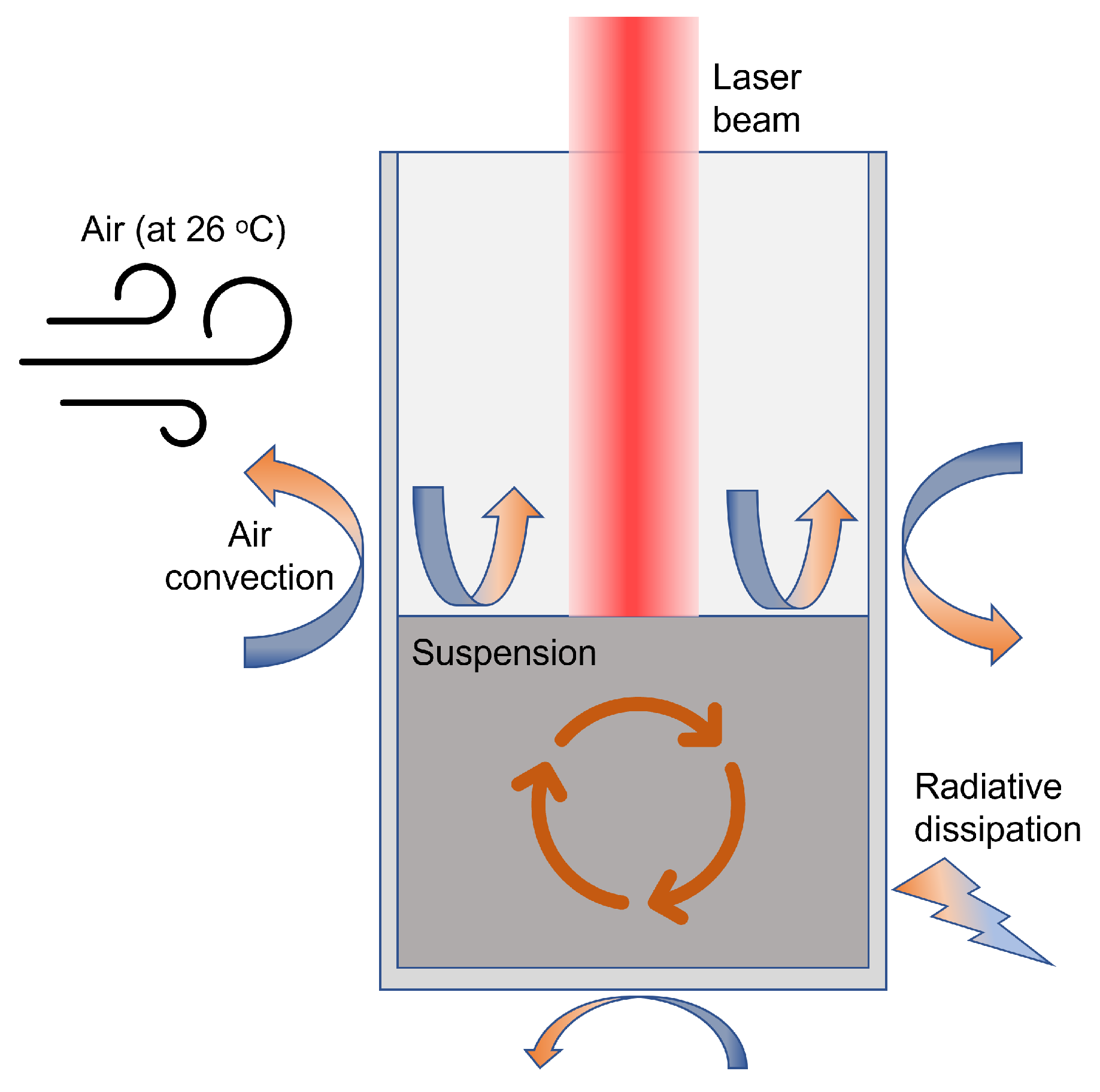

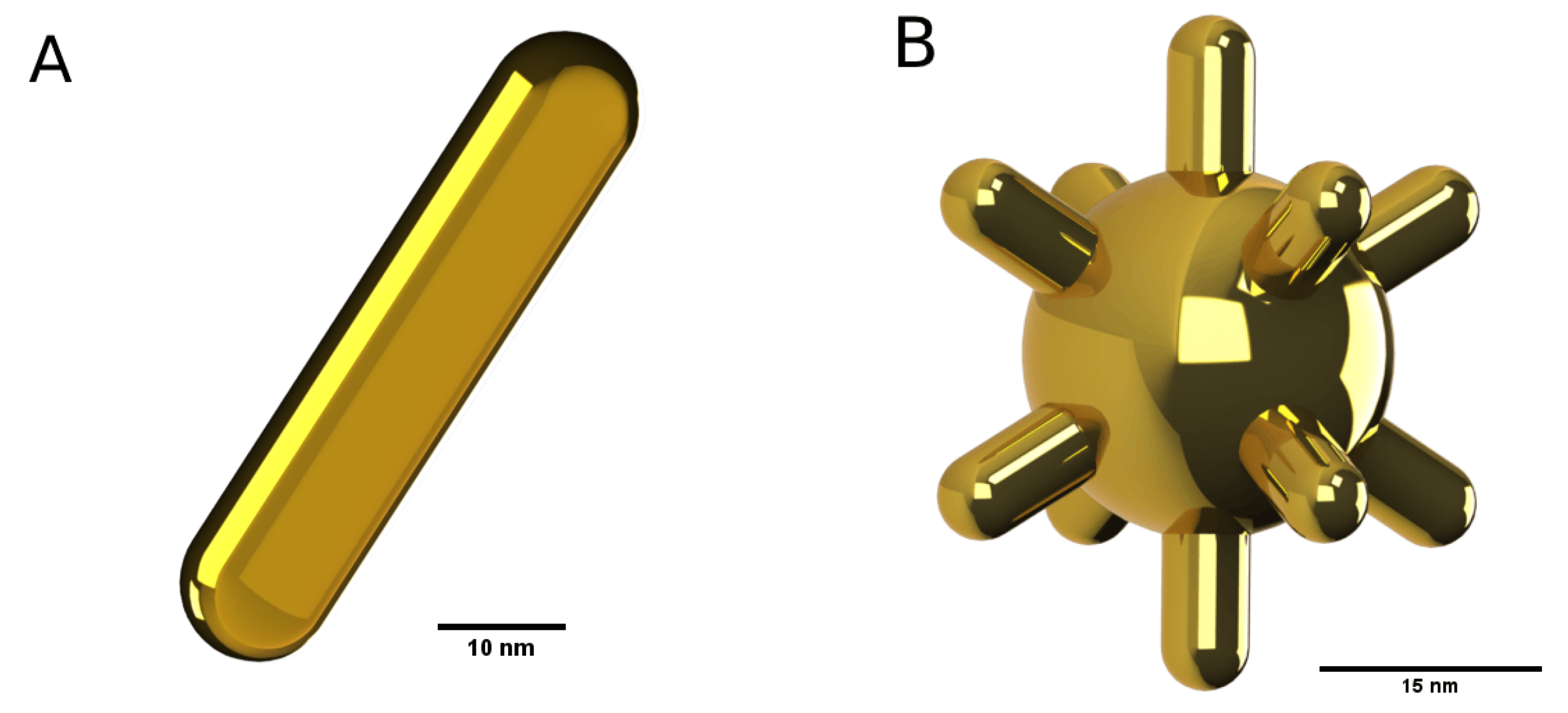


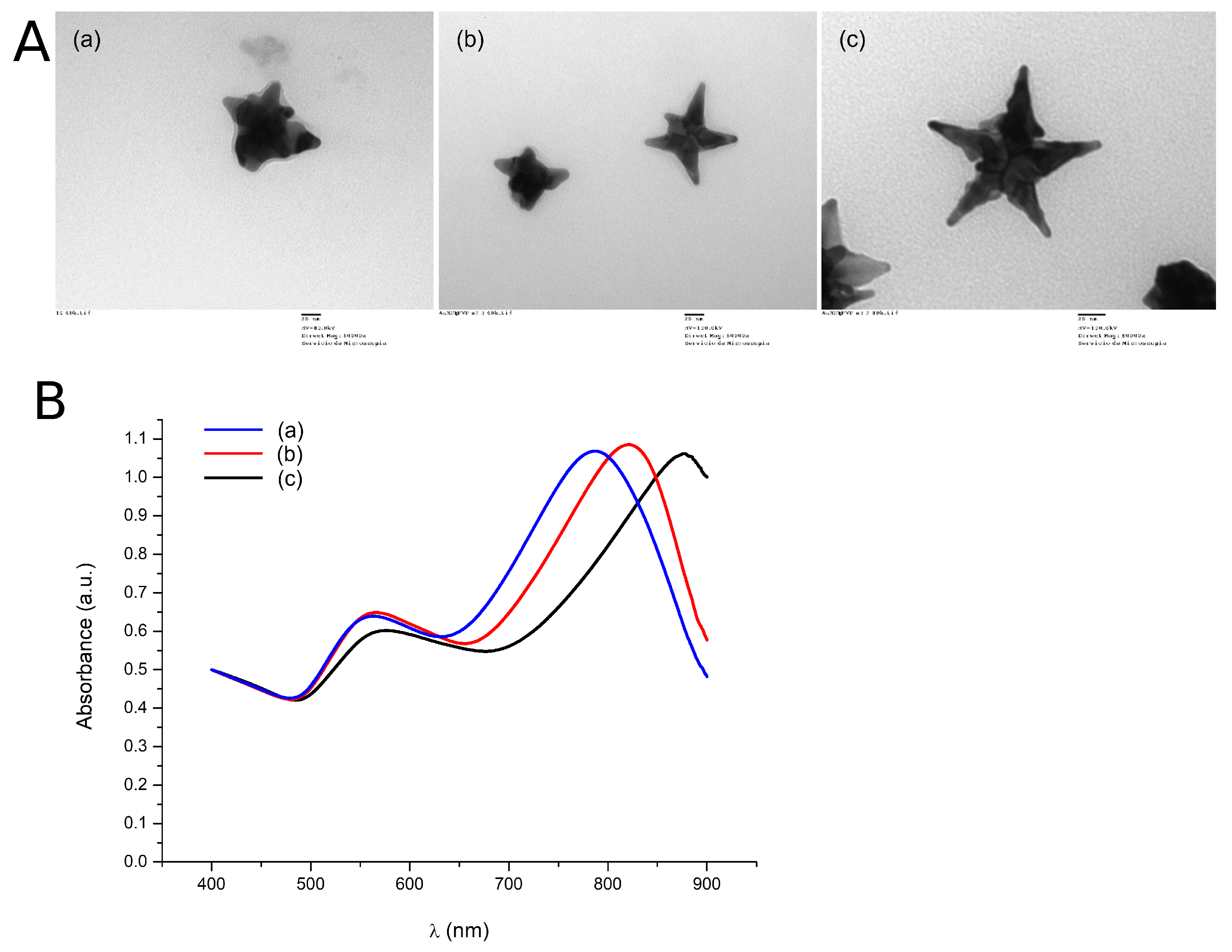
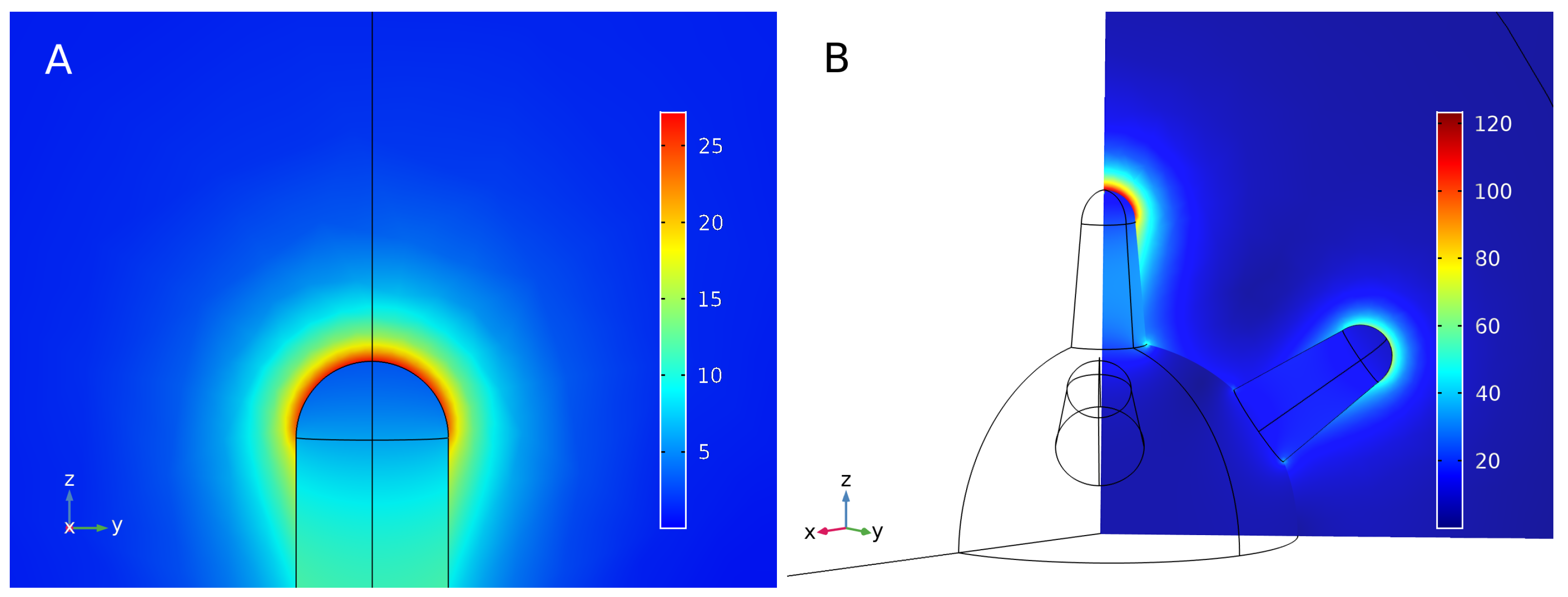
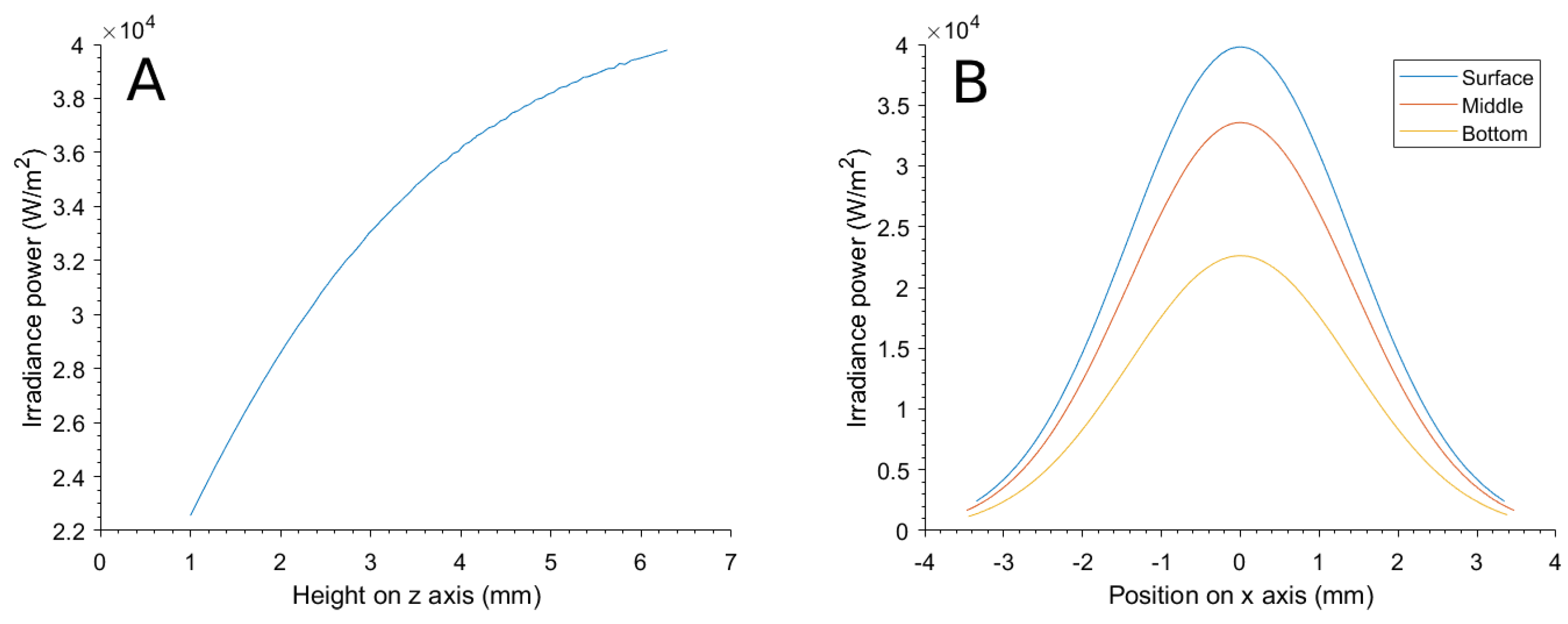
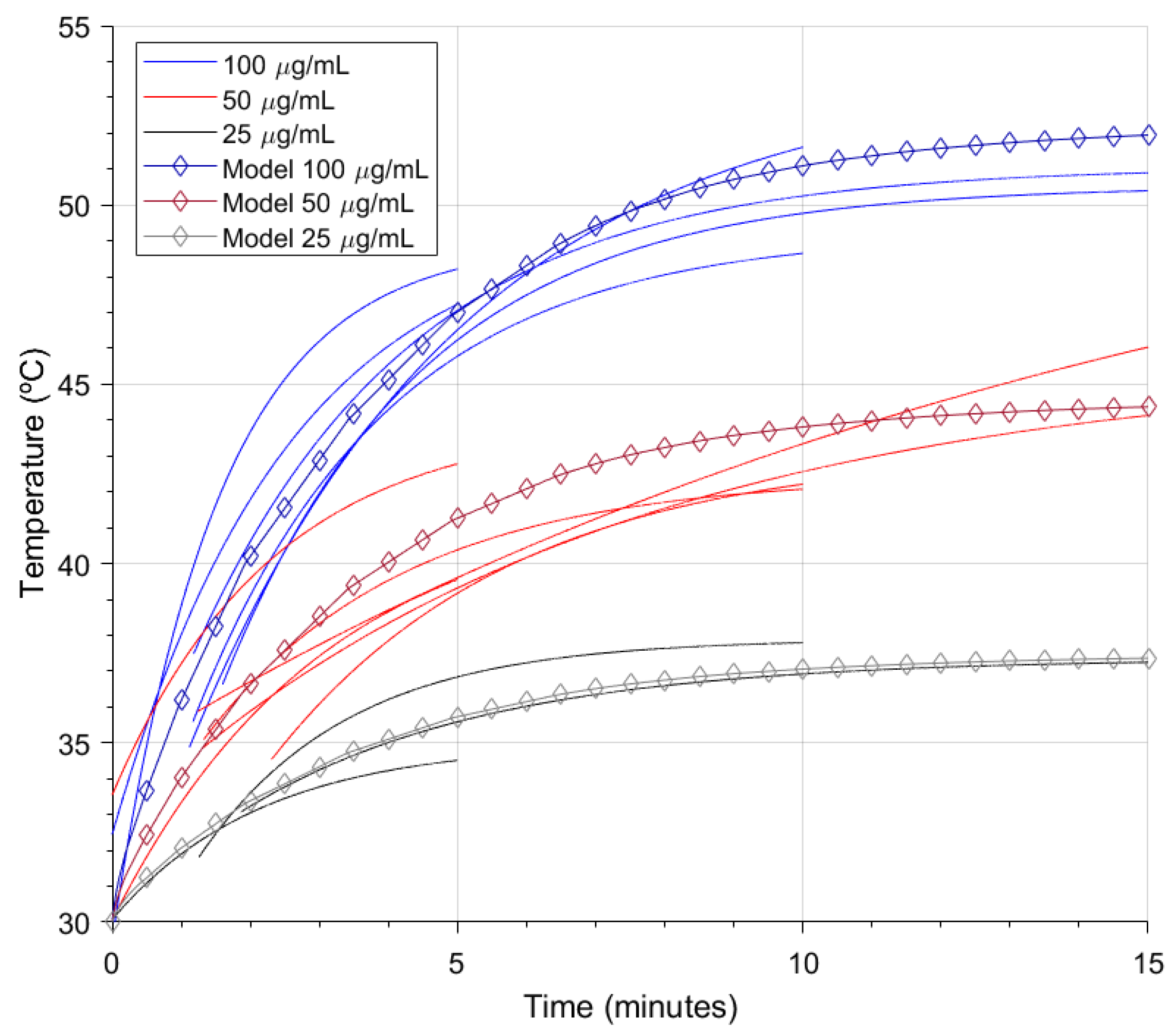
| Name | Expression | Units | Description |
|---|---|---|---|
| r0 | 6 | nm | Particle radius |
| r_sca | 150 | nm | Scattering boundary radius |
| r_pml | 200 | nm | PML domain radius |
| 1 | W/cm | Irradiance power | |
| n_med | 1.33 | 1 | Environment refractive index |
| lambda_in | 532 | nm | Laser wavelength |
| a_r | 3.5 | 1 | Aspect ratio |
| l_gnr | nm | Length of NanoRod |
Disclaimer/Publisher’s Note: The statements, opinions and data contained in all publications are solely those of the individual author(s) and contributor(s) and not of MDPI and/or the editor(s). MDPI and/or the editor(s) disclaim responsibility for any injury to people or property resulting from any ideas, methods, instructions or products referred to in the content. |
© 2023 by the authors. Licensee MDPI, Basel, Switzerland. This article is an open access article distributed under the terms and conditions of the Creative Commons Attribution (CC BY) license (https://creativecommons.org/licenses/by/4.0/).
Share and Cite
Terrés-Haro, J.M.; Monreal-Trigo, J.; Hernández-Montoto, A.; Ibáñez-Civera, F.J.; Masot-Peris, R.; Martínez-Máñez, R. Finite Element Models of Gold Nanoparticles and Their Suspensions for Photothermal Effect Calculation. Bioengineering 2023, 10, 232. https://doi.org/10.3390/bioengineering10020232
Terrés-Haro JM, Monreal-Trigo J, Hernández-Montoto A, Ibáñez-Civera FJ, Masot-Peris R, Martínez-Máñez R. Finite Element Models of Gold Nanoparticles and Their Suspensions for Photothermal Effect Calculation. Bioengineering. 2023; 10(2):232. https://doi.org/10.3390/bioengineering10020232
Chicago/Turabian StyleTerrés-Haro, José Manuel, Javier Monreal-Trigo, Andy Hernández-Montoto, Francisco Javier Ibáñez-Civera, Rafael Masot-Peris, and Ramón Martínez-Máñez. 2023. "Finite Element Models of Gold Nanoparticles and Their Suspensions for Photothermal Effect Calculation" Bioengineering 10, no. 2: 232. https://doi.org/10.3390/bioengineering10020232
APA StyleTerrés-Haro, J. M., Monreal-Trigo, J., Hernández-Montoto, A., Ibáñez-Civera, F. J., Masot-Peris, R., & Martínez-Máñez, R. (2023). Finite Element Models of Gold Nanoparticles and Their Suspensions for Photothermal Effect Calculation. Bioengineering, 10(2), 232. https://doi.org/10.3390/bioengineering10020232









